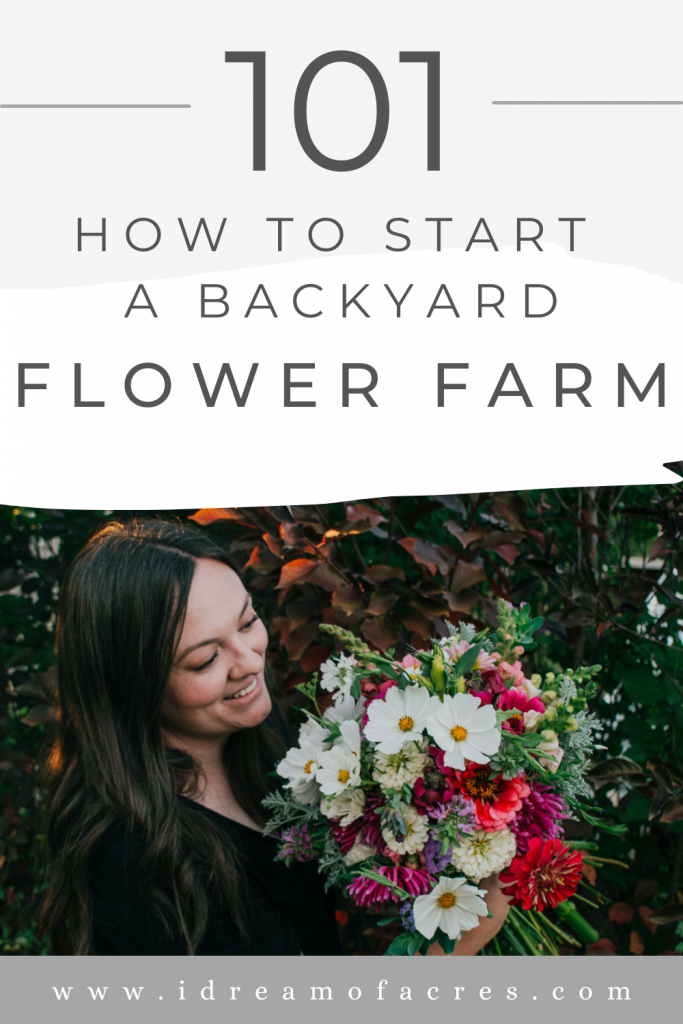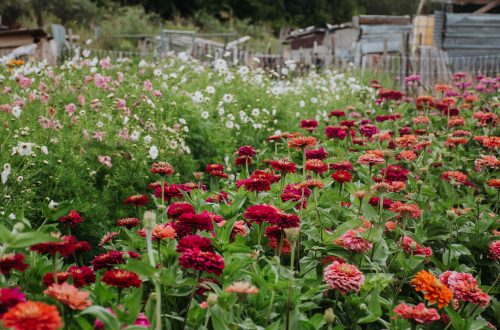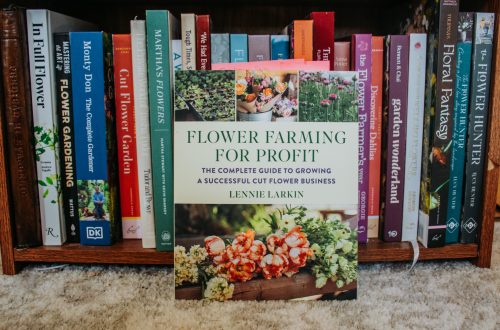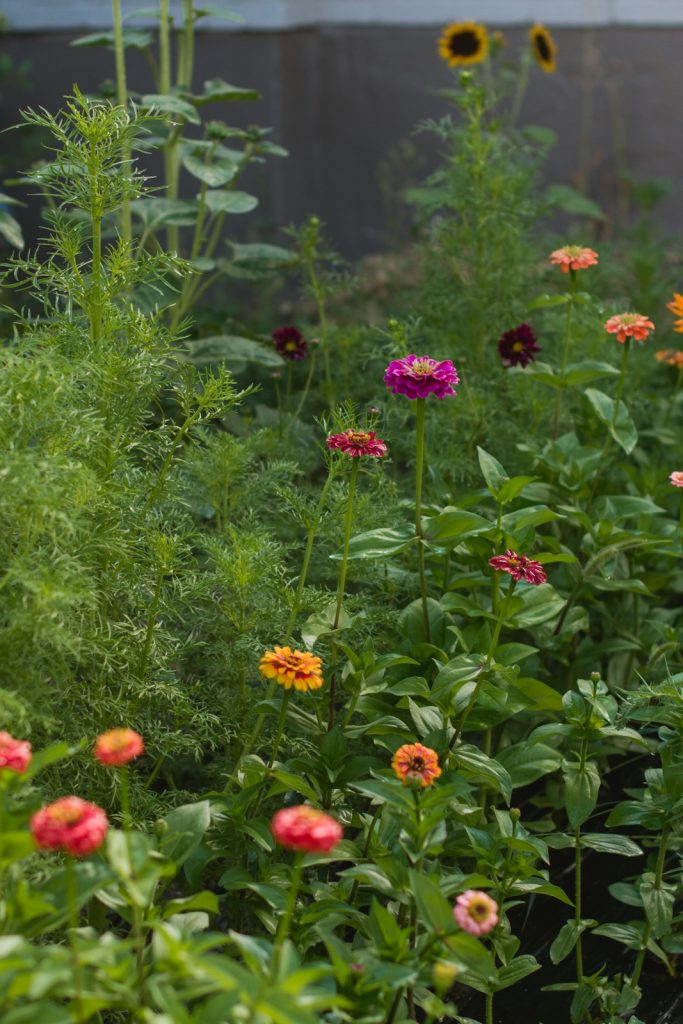
In early 2021 when I was starting my small-scale flower farm, I noticed that it was not terribly easy to find free resources to help me get going. Sure, there were a few I found right away (many of which I mention in this post), but I wanted someone who had been there before who could walk me through the process and who could tell me about what to expect from this new venture. I did find several paid courses that offered the kind of information I was looking for, but I wasn’t even positive that flower farming would be something I wanted to do long-term, so I was hesitant to drop (even more) money on it.
In the future, I might make a more advanced paid course that gets into the nitty gritty details of small-scale growing and business marketing, but for now, I’m offering this five-part blog series as a free resource to help you to know what all goes into flower farming so you can decide if it’s a good fit for you and so you can go in with both eyes wide open.
Note: There are affiliate links to the books mentioned below.
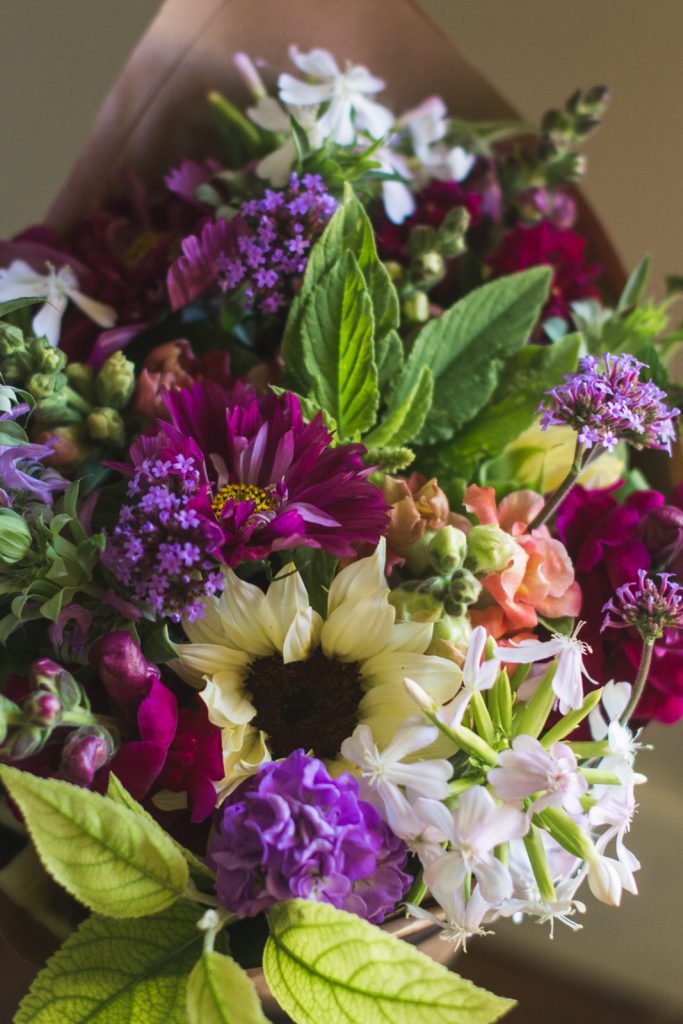
Why Flower Farming?
There has been a huge increase in the number of flower farms over the past few years. While the “slow food” movement has been around for a couple of decades and has been largely responsible for the surge in farmer’s markets, farm-to-table restaurants, and the like, “slow flowers” was a little bit behind. While some few flower farmers have been doing it for decades, most have just been flower farming for a handful of years or fewer.
Maybe your interest in the idea of flower farming started with Erin Benzakein of Floret (as it started for so many of us) — thanks to her presence on social media, her information-packed blog, and her recent series on the Magnolia Network, the idea of local flower farms has gained a lot of traction in recent years. Or maybe your interest started when you met someone who already started a small backyard flower farm, or maybe it was social media that clued you in.
However it started, I’m going to hazard a guess that at least some of the following are probably true if you’re interested in flower farming:
1 – You already have a love of growing things in general, or you’ve been drawn to the idea of gardening/homesteading for a long time.
2 – You long for a slower pace of life, or at least a simpler version of it.
3 – You not only seek out beauty, but seem to have a need to be surrounded by it.
4 – You have a seed-buying/plant-buying/bulb-buying problem, and you need to find a way to help pay for your obsession.
You’ll notice that none of the above had anything to do with making a ton of money or becoming rich. Now, I’m not saying it’s not possible with flower farming, but this is no get-rich-quick scheme. With a smart business strategy and enough land, you can definitely turn it into a full-time business…eventually. However, very few flower farmers can start out that way, and many are still working other jobs even after farming for a few years.
I say all this upfront because farming is a volatile profession. There is so much you can’t control, and a whole season’s worth of crops can be wiped out in a single storm, or with a bad pest infestation. Because of the up and down nature of flower farming, you absolutely must be in it for more than the money, or you’re not going to last. Instagram and pictures off of Floret’s website might make it seem like it’s all rosy sunsets and fields upon fields of perfect blooms, but that is simply not the reality most of the time.
Flower farming is hard work, and because you’re working with a seasonal, perishable product, it is extremely hard to take breaks, especially during certain pivotal times of your season. That means you’ll be up sowing seeds even when you’re suffering from a horrendous sinus infection, or that you’ll still be up at 6 a.m. to harvest and arrange even though you were up all night with a sick kid. You have to know that there WILL be sacrifices, and lots of them.
But because I imagine you’re still interested, let’s keep going.
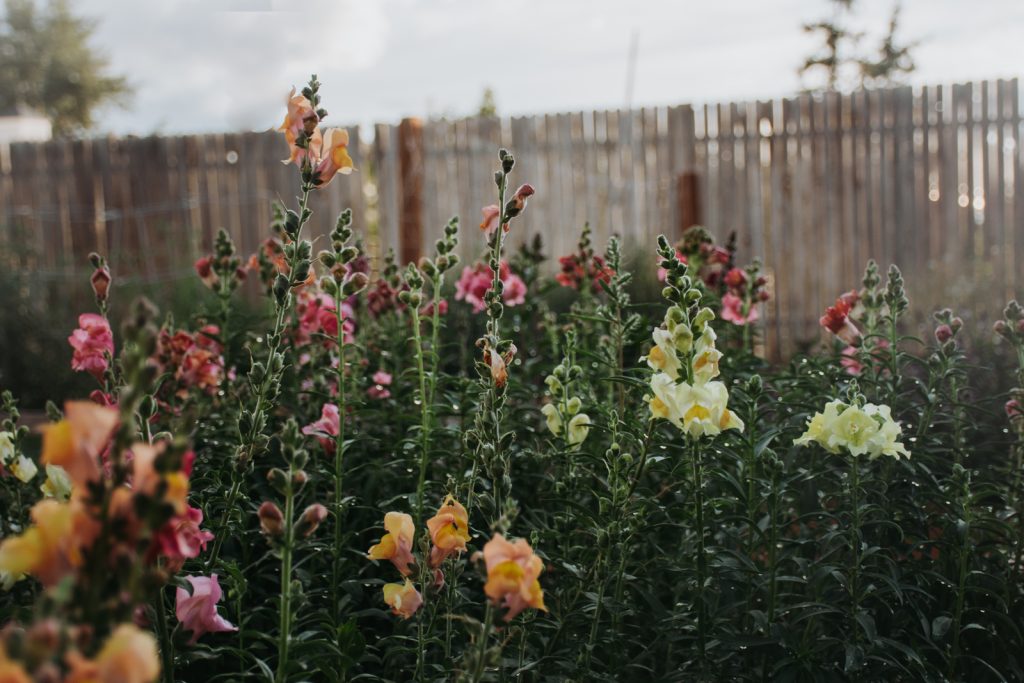
Site Selection
Before you dive into a business plan, you need to do an intense survey of the available land you have for planting. Now, this usually consists of your own backyard, but I’ve seen plenty of people get creative — do you have a neighbor with a large weedy patch they’re not using? Is there an empty lot close by that you could contact the owners to see if you could use it for planting? Do you have a relative or friend who lives close by who would let you use some of their land for your crops? (And I will also note: Once your farm starts to gain traction, you will almost certainly get more and more offers. My first year growing, I had someone offer me their half acre backyard, in addition to my next door neighbor not only offering me space in her raised beds, but also offering to start seeds and grow things for me. Once people know what you’re doing, they’ll often start coming out of the woodwork to offer you space and help.)
Your site doesn’t necessarily need to already have dirt (you can always do raised beds or a version of a no till method) or especially good soil (you can always amend it), but it DOES need to have a good amount of sunlight (ideally at least 6-8 hours a day), and it does need to be easily accessible to you and to a water source.
A few other key questions you need to answer:
Time
While your enthusiasm and big dreams might make you want to rip up every scrap of grass and cultivate every square inch you possibly can, you need to ask yourself how much time you can realistically devote to flower farming, especially in your first year. While in subsequent years, some of the labor will be taken off your shoulders because you will have frontloaded it by planting perennial crops, already having established beds, etc., that first year is such a doozy that you want to make sure you don’t try to take on too much.
My first year, I grew on less than 1,000 square feet, and I was working full-time hours during certain times of my season even with that small of a space (and that was with the help of my husband on most evenings and weekends!). During spring, I easily put in over 40 hours every week to get everything prepped and sown and planted, and then when harvesting started picking up a lot again around August, I probably put in about 30 hours a week. Certain times of the year were slower, like June and July, but I would say that most weeks, I put in a minimum of 20 hours. (Granted, I also have three small children so I’m constantly getting interrupted, which definitely adds to my time; if you don’t have small children underfoot, you can probably get things done faster than I could.)
Keep in mind that it’s not just the farming itself that takes time; your business strategy and marketing plan, your social media upkeep, and your harvesting, arranging, and selling all take significant chunks of time, too. In fact, I’d say that after the spring, the growing is by far the easiest part.
Money
It is beyond tempting to look at pictures of an established flower farm and want to get there RIGHT AWAY. It is beyond tempting to want to buy all the seeds, purchase all the plants, and put in massive bulb orders right from the get go.
Trust me, I know.
And I spent PLENTY of money that I didn’t need to spend in my first year on stuff that I didn’t really need (which you can read all about in the blog post I did on all my first year expenses).
But the BEST thing you can do for yourself is to not go into debt to start your flower farm. Let me repeat: DO NOT GO INTO DEBT TO START YOUR FLOWER FARM.
Does that mean you will have to forego buying certain plants or seeds or whatnot? YES. Does that mean you might have a more limited variety of what you’re growing? YES. Does that mean you might have to hustle a lot more rather than invest in high-cost time savers like fancy irrigation, flower plugs, and the latest in seed sowing equipment? YES.
But in the end, your real goals your first year should be three-fold: 1) Learn if you actually enjoy doing this, and if it is something you want to do long-term, 2) Learn how to actually grow things effectively, and 3) Learn how to make money doing it. The fact is, no matter how beautiful your flowers are, they will not sell themselves, and if you invest $20K into your farm only to discover that you only sell $1K your first year, you’re going to have a problem. Learn how to grow, and learn how to sell, and THEN worry about sizing up and going big with things like high tunnels, high value crops, and a lot of acreage.
Customer Base
Starting any new business venture requires doing a lot of research, and flower farming is no exception. Before you begin, you need to research what flower farms are already in your area and what they’re selling and whom they’re selling to; you need to research what outlets you might have available to you to sell your flowers (aka, farmer’s markets, grocery stores, florists, etc.), and you need to look up the number of people who live in your area, the average income, if tourism is a big part of the local economy, etc.
I live in rural Utah in one of the poorest counties in the whole state. The fact is, most people in my area can’t afford to buy expensive flowers, which was a very important consideration I had to take into account when developing my business model. I’ve discovered through trial and error that whenever I take my flowers two hours north of me every time I go to visit family up there, my stuff sells much more easily because people up in that area tend to have more disposable income.
I also live in an area where last year, upon starting my farm, I had zero competition. Literally no one else was doing what I was doing. I do have a little bit more competition now, but it’s still pretty minimal, especially as our offerings are pretty different from each other. These are all factors that I had to really think about when coming up with my business model, my price points, and my target customer.
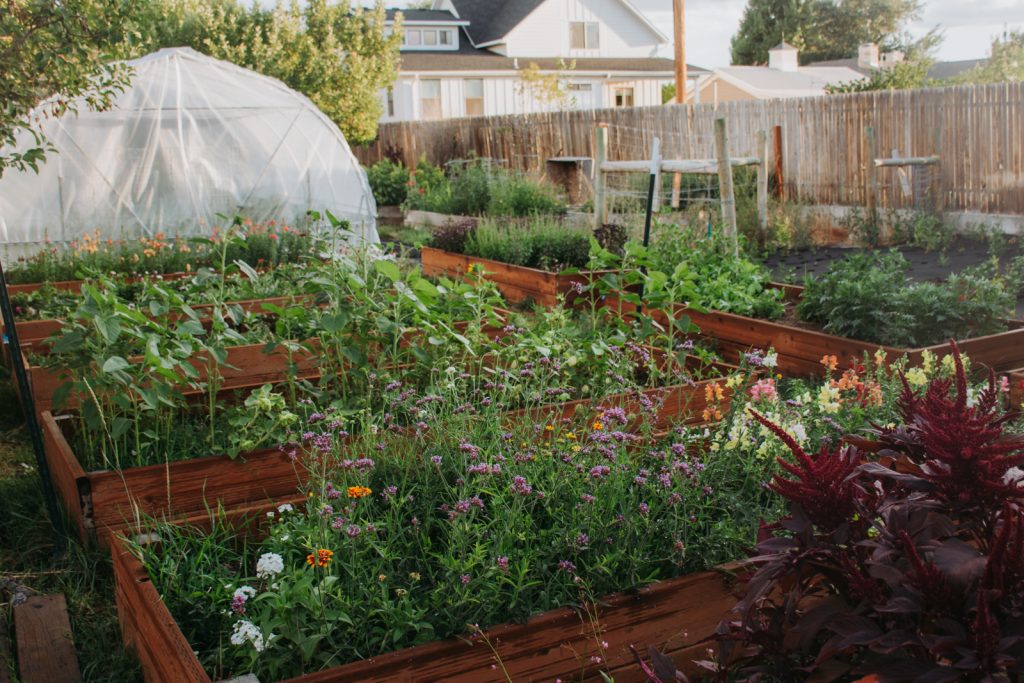
Business Plan
Once you have a really solid idea of all the considerations above, you’re ready to start formulating your business plan. The thing with flowers is that there are a LOT of different directions you can go.
Just to name a few, you can:
- Focus on being a farmer florist and provide custom bouquets and flowers for weddings, funerals, events, etc.
- Sell your flowers at a farmer’s market.
- Offer a bouquet subscription program.
- Post pop up sales on social media.
- Do a “bouquet bar” where people come and assemble their own bouquets and pay by the stem
- Do u-picks at your farm
- Offer education courses, such as bouquet- or wreath-making nights
- Open your farm to photographers for a fee
- Offer seedlings for sale in the spring, dahlia tubers in the early summer, etc.
- Sell your stems to a local florist
- Sell your flowers to a wholesaler
- Create products from dried flowers to sell
Seriously, there are a LOT of options.
However, I highly recommend narrowing down your focus to just a few, not only because if you don’t, you’ll get overwhelmed and hurtle yourself towards burnout, but also because your business plan will entirely determine WHAT you plant as well as HOW MUCH of it you plant.
For example, my main business model is to offer a CSA bouquet subscription, do pop up sales on social media when I start to have a lot of excess, and then sell weekly at the local farmer’s markets for about 5 weeks at the end of the summer. I also do a few small custom orders as they come in, usually at the rate of one or two a week.
For me, it makes a lot of sense to have a lot of variety in my planting since I’m offering bouquet subscriptions and want my customers to have different combos available every week, so I can get away with planting some color mixes and also planting smaller amounts of a lot of different kinds of things.
My first year, I THOUGHT I wanted to sell to florists as a main part of my business strategy. What I didn’t understand was that florists were generally going to want a LOT of the exact SAME thing, which I definitely couldn’t provide them. That first year, I had a florist reach out who wanted 30 Benary’s Giant orange zinnias. While I probably had 30 BG zinnias in different colors, I definitely didn’t have 30 all of one color. The same florist tried again another time with certain white flowers she wanted. While I did have some white flowers, I literally only had a stem or two of each, which just couldn’t work for the funeral she was putting together.
If you’re planning to provide flowers for wedding work, you’ll plant very different colors and flowers than you would if you were mainly doing farmer’s markets. If you’re doing bouquet subscriptions that will last without interruption for the duration of your growing season, you’re going to have different things to consider than if you’re just going to focus on a few main crops that only come up at certain times in the year (like peonies in the spring and dahlias or potted mums in the fall).
This is honestly a huge topic, and it’s one I could go on for many blog posts about. However, what I’ll do instead is direct you to a few books and resources you can check out.
Now, although I own quite a lot of flower farming and flower arranging books, I’ve noticed that not many of them focus that heavily on the business strategizing side of things. The most solid section on business strategy I’ve found thus far is in Lynn Bycqynski’s classic must-own book, The Flower Farmer. While the volume is on the older side for a flower farming book (first published in 1997 and republished in 2008), there is a positive wealth of information in it, and she goes much more into depth about the business side of things than pretty much any other book I can think of.
There are smaller chapters about selling and business strategy in Georgie Newbery’s The Flower Farmer’s Year, but it’s not nearly as extensive.
Honestly, some of the best information I’ve gotten on business strategy has actually come from following my favorite flower farmers on YouTube, which you can find a list of in my Flower Farming Resources Round-Up.
Now, what questions do you have for me?
